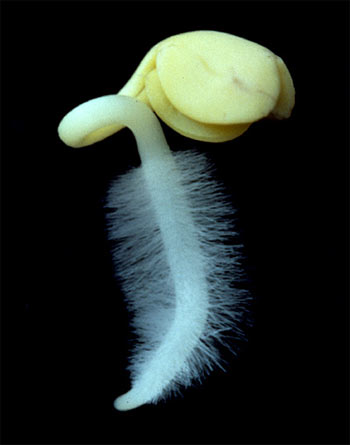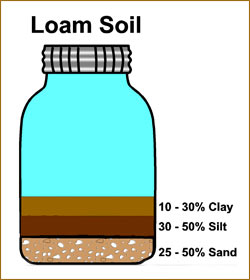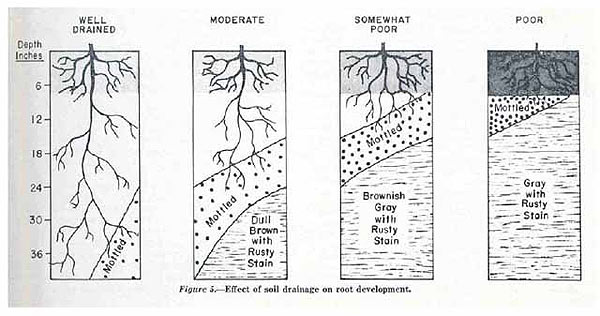 A beautiful picture of the very fine root hairs on a radish sprout. The plant absorbs all nutrients through these hairs. Image from UCA.edu
A beautiful picture of the very fine root hairs on a radish sprout. The plant absorbs all nutrients through these hairs. Image from UCA.edu
A great many people think that improving fertility means merely placing in the soil chemical elements which are part of and necessary to plants. This is but a very small part of it.
The first necessity in growing plants is water. Plants use about 300 pounds of water to produce 1 pound of solid matter. That is to say, for every pound of lumber from the forest, hay or wheat from the field, it took 300 pounds of water to sustain the plant while it is manufacturing this pound of solid matter. Plants do not eat, they only drink. The food must be in very weak solution in order for the tiny fiber roots to take it up into the chemical laboratory of the plant. The leaves allow the excess moisture to evaporate while retaining the things which they need to sustain life. Even after the fiber roots (the nutrient-absorbing part of the plant) take up the solution, it must still be in liquid form to be able to circulate.
It stands to reason that, as plants themselves are made up for the most part of water (70% to 90%), this water needs frequent renewing. In the desert all elements of fertility are present, but the country is arid. As soon as water is supplied, vegetation spring into life.
At the other extreme are marshes where there is plenty of water; temperature and climate are ideal, and yet the usual kinds of vegetation do not grow because of lack of other essentials.
Suppose, for instance, that we have achieved the ideal combination of all elements of fertility. What then goes on in the soil to transform this into stalk, leaves, and blossoms of the plant?
In your garden there are countless workers - working for you day and night, enriching the earth and making possible all plant life. These organisms are so minute that a row of 25,000 of them may be contained in an inch.
These bacteria are for the most part living in the decaying organic matter - the humus - in the soil. If there is little humus there are few bacteria. The increase of bacteria ceases when there is only 2% or 3% moisture and is most notable when there is 25 to 40 percent. Warmth, too, is necessary, and the bacteria have been found to increase enormously after a warm summer rain.
This friendly army has means of preserving itself under adverse conditions by producing spores. These spores may be called seed. In other words, a spore is a young plant that has surrounded itself with a sort of armor, hard cell, or wall, so that it may retain life amid uncongenial surroundings for years. When conditions again become suitable this shell breaks open; and the bacteria multiply in the usual manner.
These spores, lying frozen all winter in our gardens, are only waiting for the sun and rain of the springtime to awaken them to activity. This is why the character of our soil is important. If it is sand, little water is retained in it; and the air is circulated rather freely. Under these conditions it is almost impossible to keep bacteria alive because of evaporation and the easy passage of water to the lower level of the soil. Again, there is the fine-grained soil (clay), that is so compact that there is practically no space for circulation of air, and bacterial life is smothered.
This is why it is necessary to make it possible for water to enter the soil in such a manner that some of it is retained for a long period of time. Too much water is just as bad as not enough, and so it must be allowed to filter through the soil, and away from the plants. This is called drainage. By taking the two opposite kinds of soil, sand and clay, and mixing them together, using one to remedy the defects of the other, a happy solution to a drainage problem can be reached. Then if a proper amount of vegetable matter - humus - is added to this mixture, the ideal soil for most types of plants results.
 Fill a jar about 1/3 full with soil, add water to top, shake well, let settle for several days. This will reveal the components of your soil. Image from rain.org.
Fill a jar about 1/3 full with soil, add water to top, shake well, let settle for several days. This will reveal the components of your soil. Image from rain.org.
Soil Drainage
Water is essential to plant life, but it must be present in the soil in such a form that the plants can take it up. To be available, it must be stored in the tiny spaces between the soil particles; that is, it forms a thin film around each particle. But too much moisture, for most plants, is as undesirable as too little. Some plants, of course, live in water, but they are especially adapted to do so. On land, as excess of water around the soil particles keeps out the air that plant roots must obtain; it prevents the growth and activity of bacteria; and it may dissolve and wash away valuable plant food. For these reasons, surplus moisture must be removed by re-sculpting the land.
Water which enters soil during rains seeps either downward or horizontally through porous soil toward lower levels. When it reaches a layer of rock, hardpan, shale, or clay which is impervious or only slightly porous, the passage of water is stopped or slowed up. Water that collects above an impervious layer and then reemerges from the hillside at a lower elevation produces a spring.
 Diagram from cornell.edu showing how roots can't grow sufficiently in wet soils. "Effect of soil drainage on root development."
Diagram from cornell.edu showing how roots can't grow sufficiently in wet soils. "Effect of soil drainage on root development."
The depth of the growing soil above this layer determines, to a large extent, what plants will grow on the land and how well they will grow. Attention must be given both to surface runoff, so that excess water will not stand on top of the soil, and to sub-drainage, so that it will seep out of the growing layer.
Drainage does many things, but the first and most important reason for it is the fact that plant roots will not enter saturated soil. Almost all cultivated plants must have air in the soil to complete root growth and feeding processes.
In land where the water table is close to the top of the ground, the growing layer is too shallow to allow the deep rooting necessary for healthy plant growth. In heavy soil with a fairly deep growing area is summer, the water does not percolate fast enough during spring rains, and as a consequence the water table is temporarily raised.
In either of these cases, the shallow root systems that plants are able to develop in spring are unable to reach water during the summer dry spells.
Raised Beds
 Building raised beds will help significantly with improving drainage under the plants. Image from EarthEasy.
Building raised beds will help significantly with improving drainage under the plants. Image from EarthEasy.
Mounding up the soil into beds is a great way to raise the plants above a slightly soggy landscape. If your soil is poorly drained, and particularly if it's heavy clay, it would be advisable to grow your garden in raised beds. In these beds the surface of the soil is higher than the surrounding area, thus improving drainage. Raised beds also help to define an area, stop trespassing feet and make weeding and harvesting easier. They can also be designed so they are accessible to people in wheelchairs or otherwise have accessibility issues.
If drainage is not a problem, you can make a raised bed simply by piling soil higher than the surrounding area, flattening it and giving the area a slight slope on the edges. For more permanence, and better drainage, make a bed with a layer of gravel below, a layer of rough peat, sand, and gravel above that and a topping of loose compost with some of the native soil mixed in. This is all contained by a timber or brick wall.
The best height for a raised bed is between 8" and 24". Much higher than 3 feet and you'll need foundations for the retaining wall so it can support the weight of the soil. Keep the width under 5ft so you can reach in to weed and harvest the center.
For those in a wheelchair, a bed can be raised on concrete or wooden supports, like a large sink with drainage holes, and should be at least 6" deep (deeper if there are strong winds). Most herbs can grow in such a bed, but the moisture-lovers such as mint and sweet cicely will need frequent watering. If possible, confine them to a bed near to the water supply.